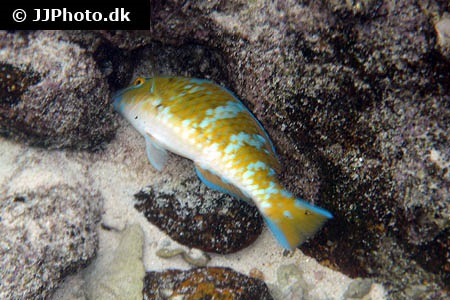Scarus ghobban

| Latin name | Scarus ghobban - Forsskål, 1775 |
|---|---|
| Local name | Blue-barred parrotfish |
| Family | Scaridae - Scarus |
| Origin | East Indian Ocean, West Indian Ocean, Australia, Japan, The Red Sea, Indonesia, East Pacific, Central/West Pacific |
| Max length | 75 cm (29.5") |
| Minimum volume |
3000 l (792 gal) |
|---|---|
| Hardiness |
Hardy |
| Suitable for aquarium |
Suitable with care |
| Reef safe |
Unknown |
| Aggressiveness | Peaceful |
| Recommended |
Macroalgea (Eg. seaweed / nori) Microalgea (Eg. spirulina) |
|---|---|
| Maybee |
Large polyp stone coral (LPS) Small polyp stone coral (SPS) |
This species needs a very large aquarium when fully grown.
Exactly how big the aquarium should be is hard to say, but the size of this species is such, that it cannot normally be kept in a home aquarium.
This species eats a great deal and demands an aquarium that can tolerate such a heavy load.
This species often has a fun and interesting personality.
This species can function in large numbers down to just one.
This species revels in swimming and requires an aquarium with ample space.
This species can change gender from female to male.
When a male is needed, a female changes sex and takes on the role.
This species can eat large amounts of algae (relative to their size) from rocks, like green hair algae and filamentous algae.
As it doesn’t eat every algae type, in case of a specific algae plague, find out more precise information.
Even though these fish enjoy a diverse type of frozen foods, it is imperative that its primary food, is algae based, thus ensuring that the fish`s immune system remains healthy.
This can, for example, be plant based fish flakes, Nori seaweed or similar.
Parrotfish (Scaridae) are effective algae eaters for the reef, but some species will also live off rock corals.
Many of these fish will grow too big for most domestic aquaria, although there are some exceptions.
Parrotfish will generally eat a lot and often, which must be taken into account.
It is an advantage to have lots of algae in the aquarium which they can graze on.
These fish will sleep in a mucus cocoon between stones.
The species most often seen in tanks is Scarus quoyi, which is suitable for coral aquaria. It does have a large appetite, so the aquarium must have good filtration.
| Aquarium trade | Yes |
|---|---|
| Distribution | Indo-Pacific: Red Sea and Algoa Bay, South Africa (Ref. 5490) to Rapa and Ducie islands, north to southern Japan, south to Perth, New South Wales. Likely at Seychelles (Ref. 1623). Eastern Pacific: Gulf of California to Ecuador (Ref. 5227). Eastern Me |
| English common names |
Green blotched parrotfish Globe-headed parrotfish Blue barred parrotfish Blue-barred parrotfish Bluebarred parrotfish Blue trim parrotfish Parrot fish |
| Danish common names |
Blåbåndet papegøjefisk |
| French common names |
Perroquet à écailles jaunes Perroquet à bord bleu Perroquet souris Perroquet à bandes bleues |
Bob Fenner. Parrotfishes, Family Scaridae - Wet Web Media - (English)
Scott W. Michael. 2009. Wrasses and Parrotfishes (Reef Fishes Series Book 5) - TFH Publications / Microcosm Ltd. - (English)
Joshua Wiegert. Parrotfish: Good or Bad for the Hobby? - Tropical Fish Hobbyist - (English)

